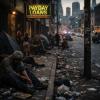
Breaking News
 US NAVY USELESS: China Activates "Land Route" to Drain Russian Silver
US NAVY USELESS: China Activates "Land Route" to Drain Russian Silver
 Lego's next-gen bricks make your creations interactive
Lego's next-gen bricks make your creations interactive
 Perhaps We Should Actually Be Focusing On Fixing America
Perhaps We Should Actually Be Focusing On Fixing America
Top Tech News
 The First Production All-Solid-State Battery Is Here, And It Promises 5-Minute Charging
The First Production All-Solid-State Battery Is Here, And It Promises 5-Minute Charging
 See inside the tech-topia cities billionaires are betting big on developing...
See inside the tech-topia cities billionaires are betting big on developing...
 Storage doesn't get much cheaper than this
Storage doesn't get much cheaper than this
 Laser weapons go mobile on US Army small vehicles
Laser weapons go mobile on US Army small vehicles
 EngineAI T800: Born to Disrupt! #EngineAI #robotics #newtechnology #newproduct
EngineAI T800: Born to Disrupt! #EngineAI #robotics #newtechnology #newproduct
 This Silicon Anode Breakthrough Could Mark A Turning Point For EV Batteries [Update]
This Silicon Anode Breakthrough Could Mark A Turning Point For EV Batteries [Update]
 Travel gadget promises to dry and iron your clothes – totally hands-free
Travel gadget promises to dry and iron your clothes – totally hands-free
 Perfect Aircrete, Kitchen Ingredients.
Perfect Aircrete, Kitchen Ingredients.
 Futuristic pixel-raising display lets you feel what's onscreen
Futuristic pixel-raising display lets you feel what's onscreen
 Cutting-Edge Facility Generates Pure Water and Hydrogen Fuel from Seawater for Mere Pennies
Cutting-Edge Facility Generates Pure Water and Hydrogen Fuel from Seawater for Mere Pennies
The Army Wants to Give Its Robots Living Muscle Tissue

The U.S. Army is looking into using animal muscle tissue as a means to move robots.
The Army Research Laboratory believes its bots could use real muscle, which allows most living things to move and manipulate their environments, instead of mechanical arms, wheels, tracks, and other systems to travel across the battlefield. The concept, which some might find disturbing, is an example of the new field of "biohybrids."
Today's military robots, particularly ground-based robots, navigate the battlefield on wheels and tracks, methods of locomotion copied over from human-occupied vehicles. But researchers "are reaching a point where they're experiencing diminishing returns in the design of these robots with wheels as their primary locomotor, and batteries as their centralized power system," NextGov reports.

 Not Worth a Continental
Not Worth a Continental

